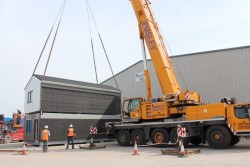The impending changes to Part L1A of the Building Regulations for new dwellings will increase energy efficiency requirements for new homes. This is the next step in the UK government's legal commitment towards lowering carbon emissions and the implementation of The Future Homes Standard being introduced by 2025. Jackie Maginnis, chief executive of the Modular & Portable Building Association, considers the implications
As an optimum building technique for timber, steel and concrete designs, volumetric modular construction is at the forefront of offsite techniques, making up 60-70% of the market. Offsite manufacturing, where homes are built along a production line in a factory, can create huge carbon savings in both embodied carbon emissions and operational carbon, which is the energy used once built.
As part of the Future Homes Standard, which is not expected to be fully consulted on until 2024, the government has outlined plans to reduce carbon emissions from homes by almost a third. The pending changes to Building Regulations once again give the modular industry a further opportunity to prove its ability to meet the challenges presented with energy efficiency.
The Future Homes Standard require that new build homes be futureproofed with low carbon heating and world-leading levels of energy efficiency. The Fabric First approach of the current Part L1A can now be considered a given.
These changes are more than simply improved U-values, reduced thermal bridging, reduced air-permeability - all challenges that volumetric technology can clearly overcome. When you think about homes for the future, you should picture properties with green technology installed as standard.
The built environment contributes around 40% of the UK's total carbon footprint, according to the UK Green Building Council. Energy efficiency is at the heart of what we do in the modular industry. Precision-engineering techniques and state-of-the-art technology allow homes to be built to at least a third more energy-efficient than traditionally built homes.
The superior build quality and the consistency of the delivered as-built performance achieved through factory manufactured solutions is the mantra for the modular sector and our members are fully aware of what they need to do to comply and, in many cases, are ahead of what is expected.
Manufacturers drive quality through ISO9001 accreditation and BBA certification, and it is due to these high standards that when it comes to thermal bridging and air permeability, tests show that on average a factory-built modular or portable building achieves air leakage of between two and three m3 per hour per m2 at 50 pascals.
There are many more examples of where exemplar quality increases carbon performance, leading to a more sustainable building - this is where volumetric construction has long since lead the charge. Back in 2006, as an association we introduced communities and local government to embodied energy.
Volumetric modular projects are constructed to the same standards required for all residential buildings, with the added benefit that the as-built performance will match the performance specified in the design brief.
The optimum technology: Volumetric modular
Modular and volumetric practices augment the construction industry with a multitude of benefits that span from greener, healthier environments to maximised sustainability, heavily reduced costs and faster build times.
Companies can deliver zero carbon homes with a high Energy Performance Certificate rating of A, putting them in the top 0.1% for energy efficiency.
The modular industry has had a remarkable impact on reducing costs while increasing quality and safety. Having gained considerable momentum over the past few years, advanced modular techniques reduce build times by an impressive 50-60% - a crucial factor in reducing the housing crisis.
Each individual material can be selected specifically for its performance characteristics, tailoring every inch of a modular build. Eco-friendly materials are often specified and waste is recycled for future projects wherever possible.
Ongoing reviews of Building Regulations, particularly the requirements for thermal, acoustic and safety performance, are quite rightly setting more onerous standards. Good performance standards require quality workmanship.
As units are factory manufactured, stringent quality control processes can be undertaken within these well-managed environments. These in-house conditions also prevent weather from inhibiting the construction process, guaranteeing efficiency. On top of this, modular construction enables site work and building processes to be completed simultaneously, reducing labour costs and build times.
Jackie Maginnis
Chief executive
Modular & Portable Building Association
www.mpba.biz
Twitter: @MPBAUK
LinkedIn: MPBAUK
Source: PBC Today









